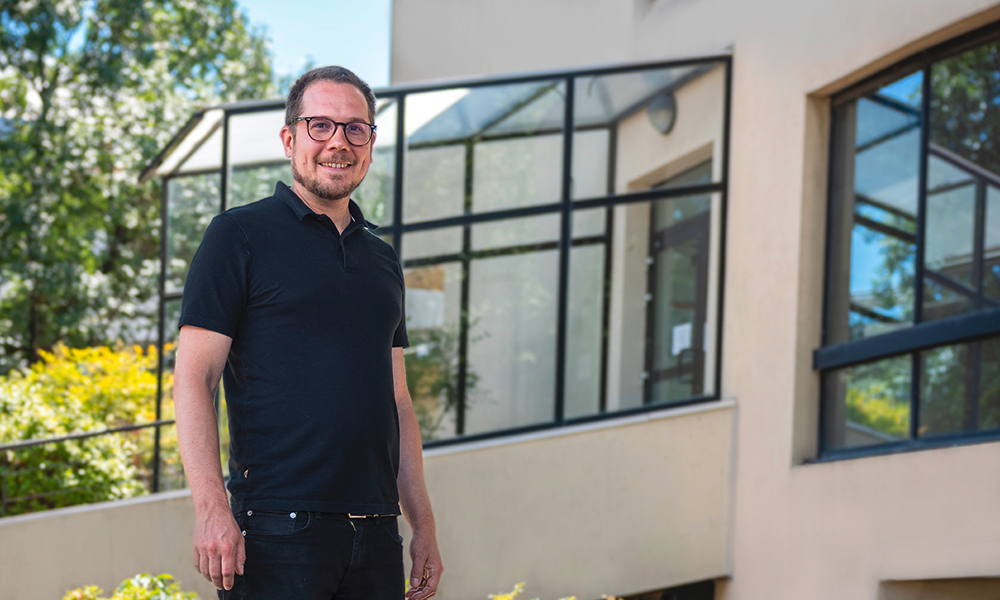
Welcome: Gergely Papp
Together with his team, Gergely Papp pushes the frontiers of technology development in the field of structural biology

‘Welcome’ might not exactly be the right word to use to introduce Gergely Papp. The newly appointed head of the Grenoble Instrumentation team actually started working at EMBL Grenoble in 2011, right after obtaining his engineering degree.
At the time, he joined the instrumentation team, then led by Florent Cipriani, as Automation Software Engineer. He’s now in charge of the team and shares with us some insights into one of EMBL’s key missions: technology development.
Can you tell us more about your work at EMBL?
I’m responsible for the EMBL Grenoble Instrumentation team, composed currently of eight engineers with specialisations in computer-assisted design, electronics, mechatronics, and software. Our team develops advanced high-precision instruments for structural biology research.
Historically, the EMBL Grenoble instrumentation team has been equipping macromolecular crystallography beamlines with specific innovative devices like cryogenic sample changers, goniometers, and humidifier devices to streamline processes through automation. Thanks to our different expertises, we are able to carry out in-house mechanical and electronics design, manufacturing and assembly, and finally, control software development for our machines. Ultimately, after a first commissioning phase at synchrotrons or at research institutes, the technology is transferred to industrial partners (ARINAX is our long-term partner) for commercialisation, so that the whole scientific community can make the most of these innovations.
More recently, we have been also focusing on technology development for cryo-electron microscopy (cryo-EM) and cryo-electron tomography (cryo-ET). We have been working over the past five years on a prototype called EasyGrid, which aims at developing a fully automated cryo-EM and cryo-ET grid preparation.
What are the challenges your team is working on?
A big part of the structural biology research community today is interested in time-resolved applications, so we are putting our minds to time-resolved approaches for both macromolecular crystallography and cryo-EM. Another important research direction that the scientific community is very excited about is multimodal imaging. We are working on the development of a multimodal sample holder which will enable sample mobility among different imaging modalities, like X-ray imaging and cryo-ET.
Lastly, another important approach in structural biology is fragment-based drug design. Proof of principle workflows have been demonstrated in the field of macromolecular crystallography, but there is still a long way to go in cryo-EM. We will be addressing these challenges in the framework of ‘Fragment Screen’, a project recently funded by the European Commission and coordinated by Instruct-ERIC, in which EMBL is one of the partners.
How important do you think collaboration is to achieving your goals?
For us, collaboration with research groups is essential. We are a team of engineers, so we need to work together with the scientists to understand their problems, which would eventually motivate the development of new instruments. The main difficulty is targeting the right problems, so that our developments can be profitable for a whole scientific field worldwide and not only to a niche of scientists.
A very good example is the collaboration that our team carried out together with the Marquez team, in charge of the High-throughput crystallisation platform (HTX Lab) at EMBL Grenoble. As the historical bottleneck for macromolecular crystallography workflow has been that crystals needed to be manually harvested by the scientists, we developed a technology called CrystalDirectTM which automatically harvests, vitrifies, and freezes protein crystals. There are now three of these instruments already deployed at different EMBL sites and increasing requests from external users to use this technology.
More recently, we integrated a CrystalDirect instrument with MASSIF-1, an automated beamline jointly operated by EMBL and the European Synchrotron Radiation Facility (ESRF). With this integration, we have put in place the first fully automated ‘protein to structure’ pipeline in the world. For this last project, we also worked closely with the McCarthy team, in charge of operating the EMBL-ESRF beamlines, and the ESRF.
What is your approach as a manager?
As a manager of a multidisciplinary team working on collaborative projects, it is essential to have a group that works well together in a good atmosphere. I believe that it is crucial to have a good knowledge of people, both from a personal point of view and from the point of view of their professional abilities. For example, as someone who has had children, I know very well how it can change so many things in one’s life.
You have to judge finely what your team members can do. This lets you assign just the right amount of tasks to each person so they are stimulated but not overwhelmed with work. You have to give them exciting challenges and the means to solve them. Finally, I think that giving constructive feedback and pushing people in a positive way is very important, so that we can all work together as a team and not only as a set of individuals.
Why did you want to become an engineer? What other career might you have pursued had you not become one?
My grandfather had a very important influence on my career path. He was himself an electrical engineer and he started to teach me physics principles from a very young age. We also did a lot of DIY projects together.
Otherwise, I was also very much into music and I started playing drums at the age of nine. At 18, when I had to choose my career path, I seriously considered becoming a musician! My parents pushed me towards a more stable career and I finally chose engineering, but music has remained very important for me and I still play drums and bass as a hobby.
What is the book you are most likely to recommend to people you meet?
As a science fiction reader, my favourite book is The Foundation by Isaac Asimov. I found it very well structured and written. I also enjoy reading Arthur C. Clarke or Bernard Werber.


